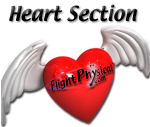FlightPhysical.com will discuss Hypertension in sections. This parallels the FAA's instructions to AMEs concerning this common and serious problem.
Hypertension (or high blood pressure) is a common condition where the pressure of the blood flowing through the arteries of the body is higher than it should be. Pilots and controllers are often affected whether or not they have the classic "type A" personality. Much like the pressure of the air in a tire, if the pressure of the blood is too high it can damage the arteries and organs of the body. Just like the tire, if the pressure suddenly becomes very high, catastrophic events can happen. Similarly, if the pressure remains somewhat elevated for a long enough period of time, premature wear and failure can occur. As you research hypertensin in aviators, you will want to review Measurement of Hypertension during the Pilot Exam Click on links for the procedures for specific FAA instructions on initial reporting, medication discussion and followup procedures: List of Medical Problems |
Exam Info | Online Scheduling Info | Find AME | Pilot FAQs | Sport Pilots | Part 67 Medical Standards | Blood Pressure | Part 61 Flight Certification |DUI | Waivers
How Site Works | Online Scheduling | Update my Page | Links | Prices | Email | Pay Bill | AME FAQs | Trade Equipment | AME Guide
Pilot FAQs | AME FAQs | FAQ's By Medical Problem | Sport Pilot | Blood Pressure | Scheduling | Contact Us
Exam Info | Synopsis of Standards |CFR Part 67 | Exam Classes | Class 1 Requirements | Class 2 | Class 3 | Problem List | Waivers | Blood Pressure
subglobal6 link | subglobal6 link | subglobal6 link | subglobal6 link | subglobal6 link | subglobal6 link | subglobal6 link


